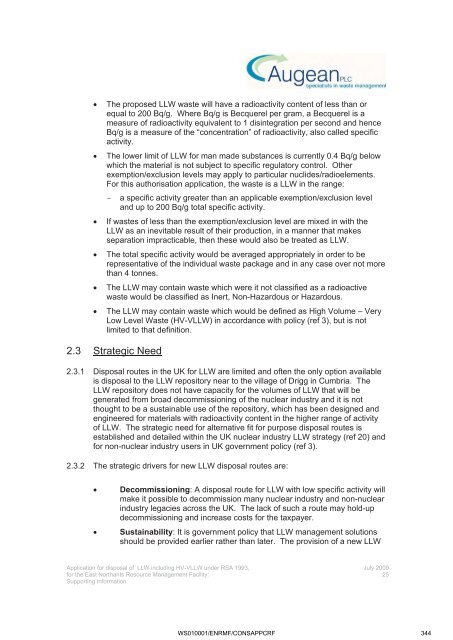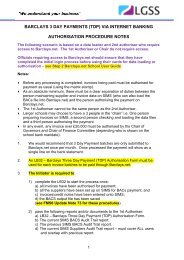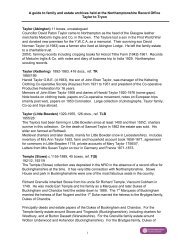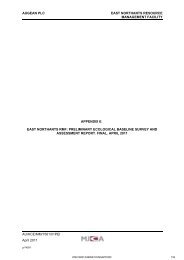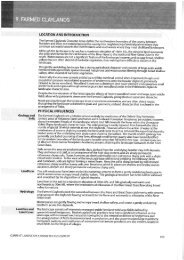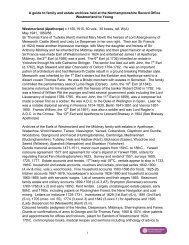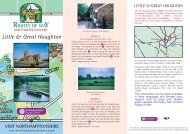- Page 1 and 2: AUGEAN PLC EAST NORTHANTS RESOURCE
- Page 3 and 4: Preface This authorisation applicat
- Page 5 and 6: Wound Exposure 8.5 Pre-Closure - no
- Page 7 and 8: Summary Introduction S1 This docume
- Page 9 and 10: Radioactivity & Risk S12 This summa
- Page 11 and 12: The LLW Disposal Proposal S24 The a
- Page 13 and 14: Key Facts Summary Operational Legal
- Page 15 and 16: S32 The actual capacity of the land
- Page 17 and 18: S40 What are the impacts of transpo
- Page 19 and 20: Annex to the Summary: What is Radio
- Page 21 and 22: How Does Radiation Interact with th
- Page 23 and 24: Supporting Information for the Appl
- Page 25: 2.0 Authorisation 2.1 Background 2.
- Page 29 and 30: Objective/Principle/Requirement fro
- Page 31 and 32: 3.1.3 The HPA have recently issued
- Page 33 and 34: Hazardous waste landfills receive w
- Page 35 and 36: easonable attempts have been made t
- Page 37 and 38: 3.6.6 This application document doe
- Page 39 and 40: 3.10.7 The new regulations to trans
- Page 41 and 42: 4.2 Business Plans and Site Develop
- Page 43 and 44: upper bound on the region of dose o
- Page 45 and 46: proposed that if the waste has an u
- Page 47 and 48: y the authorisations for transfer i
- Page 49 and 50: 5.4.9 Each package or self-similar
- Page 51 and 52: 5.6 Disposal, Waste Emplacement, Co
- Page 53 and 54: package and additional shielding (f
- Page 55 and 56: 6.0 Waste Disposal History 6.0.1 Th
- Page 57 and 58: 8.0 Radioactive Waste Disposal Cons
- Page 59 and 60: Scenario Annual Dose Criteria Publi
- Page 61 and 62: 8.1.9 Additional ALARA precautions
- Page 63 and 64: 8.3 Pre-Closure - not expected to o
- Page 65 and 66: Doses from Dropped Load Scenario In
- Page 67 and 68: - The crater size can be estimated
- Page 69 and 70: 8.5 Pre-Closure - not expected to o
- Page 71 and 72: Nuclide Maximum Leachate Authorisat
- Page 73 and 74: 8.9 Post-Closure - expected to occu
- Page 75 and 76: 8.10 Post-Closure - expected to occ
- Page 77 and 78:
Groundwater Pathway, Site Boundary
- Page 79 and 80:
Intrusion (Table 5.3, Annex B) "Int
- Page 81 and 82:
Intrusion (Table 5.3, Annex B) "Res
- Page 83 and 84:
8.15 Results of the Assessment Scen
- Page 85 and 86:
8.16 Landfill Radiological Capacity
- Page 87 and 88:
Radiological Capacity (MBq) (0.02 m
- Page 89 and 90:
8.16.5 The likely conclusion is tha
- Page 91 and 92:
With the additional constraint that
- Page 93 and 94:
Limit values are prescribed for cer
- Page 95 and 96:
nuclides (including appropriate dau
- Page 97 and 98:
10.0 BPEO Assessment for Disposal o
- Page 99 and 100:
the Environmental Permitting Regula
- Page 101 and 102:
12.0 Landfill Engineering and BAT F
- Page 103 and 104:
13.0 Waste Hierarchy and Waste Mini
- Page 105 and 106:
ECOLOGY and NATURE CONSERVATION Woo
- Page 107 and 108:
15.2 Augean’s Core Business Value
- Page 109 and 110:
15.5 Augean Organisation Group Tech
- Page 111 and 112:
CPR 04 Off loading of palletised wa
- Page 113 and 114:
15.7 Arrangements Specific to LLW D
- Page 115 and 116:
17.0 The Application Forms 17.1 Was
- Page 117 and 118:
References 1 Process and Informatio
- Page 119 and 120:
Figures Application for disposal of
- Page 121 and 122:
WS010001/ENRMF/CONSAPPCRF 439
- Page 123 and 124:
analysis, sensitivity. A quantitati
- Page 125 and 126:
closure. Administrative and technic
- Page 127 and 128:
dose. A measure of the energy depos
- Page 129 and 130:
HPA (NRPB) The Health Protection Ag
- Page 131 and 132:
model. A representation of a system
- Page 133 and 134:
adioactive material. Material desig
- Page 135 and 136:
safety culture. The assembly of cha
- Page 137 and 138:
uranium, enriched. Uranium containi
- Page 139 and 140:
Annexes A Radiation, People and the
- Page 141 and 142:
WS010001/ENRMF/CONSAPPCRF 459
- Page 143 and 144:
WS010001/ENRMF/CONSAPPCRF 461
- Page 145 and 146:
the
- Page 147 and 148:
WS010001/ENRMF/CONSAPPCRF 465
- Page 149 and 150:
WS010001/ENRMF/CONSAPPCRF 467
- Page 151 and 152:
WS010001/ENRMF/CONSAPPCRF 469
- Page 153 and 154:
WS010001/ENRMF/CONSAPPCRF 471
- Page 155 and 156:
WS010001/ENRMF/CONSAPPCRF 473
- Page 157 and 158:
WS010001/ENRMF/CONSAPPCRF 475
- Page 159 and 160:
WS010001/ENRMF/CONSAPPCRF 477
- Page 161 and 162:
WS010001/ENRMF/CONSAPPCRF 479
- Page 163 and 164:
WS010001/ENRMF/CONSAPPCRF 481
- Page 165 and 166:
WS010001/ENRMF/CONSAPPCRF 483
- Page 167 and 168:
WS010001/ENRMF/CONSAPPCRF 485
- Page 169 and 170:
WS010001/ENRMF/CONSAPPCRF 487
- Page 171 and 172:
WS010001/ENRMF/CONSAPPCRF 489
- Page 173 and 174:
WS010001/ENRMF/CONSAPPCRF 491
- Page 175 and 176:
WS010001/ENRMF/CONSAPPCRF 493
- Page 177 and 178:
WS010001/ENRMF/CONSAPPCRF 495
- Page 179 and 180:
WS010001/ENRMF/CONSAPPCRF 497
- Page 181 and 182:
WS010001/ENRMF/CONSAPPCRF 499
- Page 183 and 184:
WS010001/ENRMF/CONSAPPCRF 501
- Page 185 and 186:
WS010001/ENRMF/CONSAPPCRF 503
- Page 187 and 188:
WS010001/ENRMF/CONSAPPCRF 505
- Page 189 and 190:
WS010001/ENRMF/CONSAPPCRF 507
- Page 191 and 192:
WS010001/ENRMF/CONSAPPCRF 509
- Page 193 and 194:
WS010001/ENRMF/CONSAPPCRF 511
- Page 195 and 196:
WS010001/ENRMF/CONSAPPCRF 513
- Page 197 and 198:
WS010001/ENRMF/CONSAPPCRF 515
- Page 199 and 200:
WS010001/ENRMF/CONSAPPCRF 517
- Page 201 and 202:
WS010001/ENRMF/CONSAPPCRF 519
- Page 203 and 204:
WS010001/ENRMF/CONSAPPCRF 521
- Page 205 and 206:
WS010001/ENRMF/CONSAPPCRF 523
- Page 207 and 208:
WS010001/ENRMF/CONSAPPCRF 525
- Page 209 and 210:
WS010001/ENRMF/CONSAPPCRF 527
- Page 211 and 212:
WS010001/ENRMF/CONSAPPCRF 529
- Page 213 and 214:
WS010001/ENRMF/CONSAPPCRF 531
- Page 215 and 216:
WS010001/ENRMF/CONSAPPCRF 533
- Page 217 and 218:
WS010001/ENRMF/CONSAPPCRF 535
- Page 219 and 220:
WS010001/ENRMF/CONSAPPCRF 537
- Page 221 and 222:
WS010001/ENRMF/CONSAPPCRF 539
- Page 223 and 224:
WS010001/ENRMF/CONSAPPCRF 541
- Page 225 and 226:
WS010001/ENRMF/CONSAPPCRF 543
- Page 227 and 228:
Radiological Assessment for Disposa
- Page 229 and 230:
Radiological Assessment 0820-2 Vers
- Page 231 and 232:
Radiological Assessment 0820-2 Vers
- Page 233 and 234:
Radiological Assessment 0820-2 Vers
- Page 235 and 236:
Radiological Assessment 0820-2 Vers
- Page 237 and 238:
Radiological Assessment 0820-2 Vers
- Page 239 and 240:
Radiological Assessment 0820-2 Vers
- Page 241 and 242:
Radiological Assessment 0820-2 Vers
- Page 243 and 244:
Radiological Assessment 0820-2 Vers
- Page 245 and 246:
Radiological Assessment 0820-2 Vers
- Page 247 and 248:
Radiological Assessment 0820-2 Vers
- Page 249 and 250:
Radiological Assessment 0820-2 Vers
- Page 251 and 252:
Radiological Assessment 0820-2 Vers
- Page 253 and 254:
Radiological Assessment 0820-2 Vers
- Page 255 and 256:
Radiological Assessment 0820-2 Vers
- Page 257 and 258:
Radiological Assessment 0820-2 Vers
- Page 259 and 260:
Radiological Assessment 0820-2 Vers
- Page 261 and 262:
Radiological Assessment 0820-2 Vers
- Page 263 and 264:
Radiological Assessment 0820-2 Vers
- Page 265 and 266:
Radiological Assessment 0820-2 Vers
- Page 267 and 268:
Radiological Assessment 0820-2 Vers
- Page 269 and 270:
Radiological Assessment 0820-2 Vers
- Page 271 and 272:
Radiological Assessment 0820-2 Vers
- Page 273 and 274:
4.3.2 Fire Radiological Assessment
- Page 275 and 276:
Radiological Assessment 0820-2 Vers
- Page 277 and 278:
Radiological Assessment 0820-2 Vers
- Page 279 and 280:
Radiological Assessment 0820-2 Vers
- Page 281 and 282:
Radiological Assessment 0820-2 Vers
- Page 283 and 284:
Radiological Assessment 0820-2 Vers
- Page 285 and 286:
Radiological Assessment 0820-2 Vers
- Page 287 and 288:
Radiological Assessment 0820-2 Vers
- Page 289 and 290:
Radiological Assessment 0820-2 Vers
- Page 291 and 292:
Radiological Assessment 0820-2 Vers
- Page 293 and 294:
Radiological Assessment 0820-2 Vers
- Page 295 and 296:
Radiological Assessment 0820-2 Vers
- Page 297 and 298:
Radiological Assessment 0820-2 Vers
- Page 299 and 300:
Radiological Assessment 0820-2 Vers
- Page 301 and 302:
Radiological Assessment 0820-2 Vers
- Page 303 and 304:
Radiological Assessment 0820-2 Vers
- Page 305 and 306:
Radiological Assessment 0820-2 Vers
- Page 307 and 308:
Radiological Assessment 0820-2 Vers
- Page 309 and 310:
Radiological Assessment 0820-2 Vers
- Page 311 and 312:
Radiological Assessment 0820-2 Vers
- Page 313 and 314:
Radiological Assessment 0820-2 Vers
- Page 315 and 316:
Radiological Assessment 0820-2 Vers
- Page 317 and 318:
Radiological Assessment 0820-2 Vers
- Page 319 and 320:
Radiological Assessment 0820-2 Vers
- Page 321 and 322:
Radiological Assessment 0820-2 Vers
- Page 323 and 324:
Annex C ENRMF, IRRs 1999, Radiation
- Page 325 and 326:
2 VERSION 3, 14 July 2009 year, and
- Page 327 and 328:
2 RADIATION RISKS FROM NORMAL OPERA
- Page 329 and 330:
6 VERSION 3, 14 July 2009 Thus, dus
- Page 331 and 332:
8 VERSION 3, 14 July 2009 protectio
- Page 333 and 334:
10 VERSION 3, 14 July 2009 Access t
- Page 335 and 336:
12 VERSION 3, 14 July 2009 clean an
- Page 337 and 338:
APPENDIX TO ENRMF RISK ASSESSMENT 1
- Page 339 and 340:
Radionuclide Dose coefficient (Sv/B
- Page 341 and 342:
Technical Services Group NOT PROTEC
- Page 343 and 344:
1 INTRODUCTION NOT PROTECTIVELY MAR
- Page 345 and 346:
NOT PROTECTIVELY MARKED Figure 3: D
- Page 347 and 348:
4 REFERENCES NOT PROTECTIVELY MARKE
- Page 349 and 350:
Annex F Application Form WS010001/E
- Page 351 and 352:
Contents A For Office Use B Company
- Page 353 and 354:
East Northamptonshire Council Count
- Page 355 and 356:
E Type of Application E1 When would
- Page 357 and 358:
13.2 Illumination - Use of radiolum
- Page 359 and 360:
Please note that Environment Agency
- Page 361 and 362:
H6 How do you intend to measure or
- Page 363 and 364:
I13 What is the total monthly volum
- Page 365 and 366:
J Organic Liquid Waste Accumulation
- Page 367 and 368:
Transfer to a contractor Please pro
- Page 369 and 370:
Disposal of very low level solid wa
- Page 371 and 372:
1 0 Solid waste continued L14 How d
- Page 373 and 374:
L29 What is the maximum annual disp
- Page 375 and 376:
M2 Do you wish to have the standard
- Page 377 and 378:
WS010001/ENRMF/CONSAPPCRF 695
- Page 379 and 380:
*Note - These terms are explained i
- Page 381 and 382:
Documentary evidence of measures ta
- Page 383 and 384:
E-mail S18 What is the address of t
- Page 385 and 386:
Please give the county council unle
- Page 387 and 388:
Example Capacity Calculation Layout
- Page 389 and 390:
Annex H Calculation of dose rate at
- Page 391 and 392:
NOT PROTECTIVELY MARKED Table of Co
- Page 393 and 394:
NOT PROTECTIVELY MARKED 2.3 MicroSh
- Page 395 and 396:
3.3 Covering soil material thicknes
- Page 397 and 398:
NOT PROTECTIVELY MARKED APPENDIX A
- Page 399 and 400:
Report Determination of 238 U, 235
- Page 401 and 402:
Job reference number GAU1278 (Final
- Page 403 and 404:
3 H Job reference number GAU1278 (F
- Page 405 and 406:
Job reference number GAU1278 (Final
- Page 407 and 408:
Annex J Capability Statements WS010
- Page 409 and 410:
Peter Shaw Job Title - Group Leader
- Page 411 and 412:
Galson Sciences Limited July 2009 D
- Page 413:
1987 - 2005: Director of Environmen


